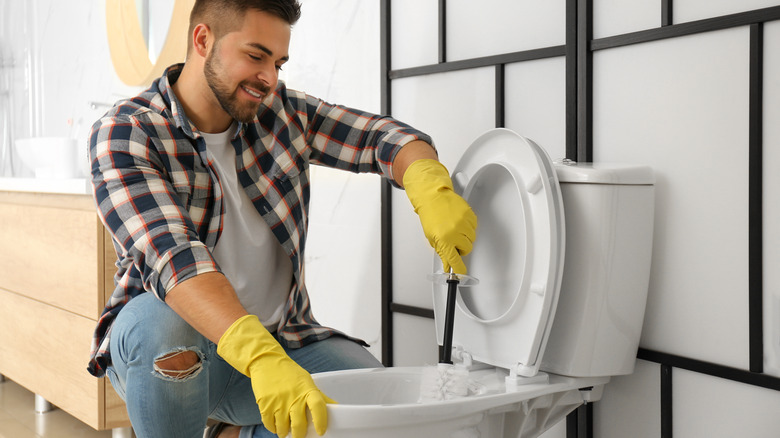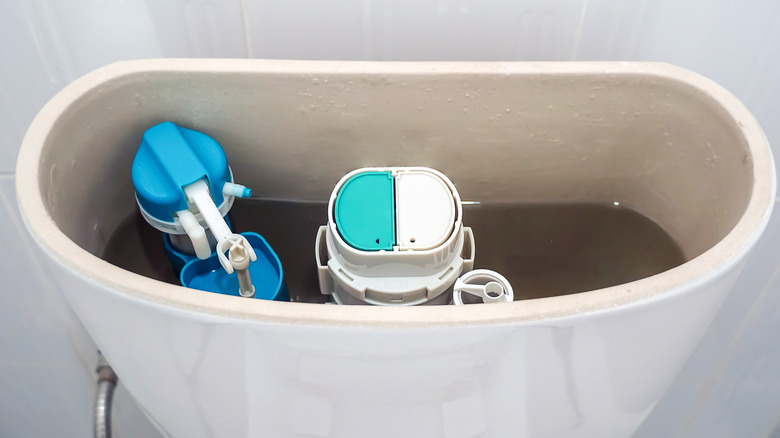This Is What Happens When You Put Vinegar In Your Toilet
When you're looking for a natural cleaning powerhouse, free of harsh fumes and skin irritants, white vinegar should be at the top of your list. Its acidity can cut through grime, eliminate stains, and stop odor in its tracks, making it a great tool for cleaning your toilet and a great way to avoid common cleaning mistakes.
Yet another perk? Vinegar is extremely affordable, especially when compared to pricey, name-brand cleaners. According to Get Green Be Well, you can stretch your money even further if you put the vinegar into a spray bottle for controlled coverage, as opposed to pouring it directly from the container. While vinegar is thoroughly effective on its own, you can also add baking soda to the mix if you need more gritty scrubbing power.
If you're worried that vinegar doesn't have the same antibacterial qualities as other cleaners, don't be. "The acidity in vinegar kills germs, bacteria and mold on contact," WELL Accredited Professional Kimberly Button told Get Green Be Well. Really? Really.
Let's find out what happens when you put vinegar in your toilet.
Cleaning your toilet bowl with vinegar is quick and easy
Still doubting vinegar's powers as a cleaning hack? Pour some into your toilet and see what happens. Whether you choose to let it soak or help it along with some scrubbing, prepare to see stubborn stains vanish before your eyes and leave nothing but a sparkling clean bowl.
Get Green Be Well warns about choosing the right type of vinegar for the job — always use white vinegar. Though apple cider vinegar cleans just as effectively, its brown coloring can stain the porcelain.
According to the popular housekeeping column Hints from Heloise, cleaning your toilet bowl with vinegar is a quick and easy process. You'll only need white vinegar, baking soda, and a toilet scrub brush. "Pour a generous glug of vinegar, followed by a heavy sprinkling of baking soda, into the bowl," says Heloise. "While the mixture is bubbling up, scrub the bowl (get under the rim, too). Let it soak for 30 minutes and flush. That's it." If you need an added boost to try to remove a stain, Heloise days you can "use undiluted vinegar directly on the stain and scrub with a brush."
And remember, adding vinegar to a spray bottle also makes for easy cleaning on the seat and the outside of the toilet, but what about the toilet tank? Don't forget that realm!
Vinegar can be used inside the toilet tank too
White Vinegar can also be used inside the tank of your toilet — an area that many of us neglect to clean. According to This Old House, "The inside part of the tank can harbor rust, mold, mildew, and bacteria that can cause unpleasant odors and impair your toilet's functionality and longevity." Here's how to tackle the tank with the power of white vinegar.
This Old House recommends donning a pair of rubber gloves before removing your tank cover. "Without draining out the water, pour white vinegar into the tank, stopping at least an inch below the top rim," the site says. "Let the vinegar-water solution sit for 12 hours to dissolve mineral deposits, rust, and mildew."
When the time is up, give the toilet a couple flushes, then turn off the toilet's water valve. "Flush the toilet again to completely drain the water from the tank." Now it's time to get your trusty scrub brush and sponge to clean the walls of the tank. "Turn the water back on, flush the toilet again, and confirm the water is clear in both the tank and the bowl," says This Old House. Last but not least, replace the lid. If you're dealing with a really nasty tank, This Old House recommends using straight vinegar and letting it sit overnight.
The next time your bathroom needs a deep clean, no need to run to the store for harsh chemicals. The only stop you need to make is your very own pantry for that bottle of vinegar.


